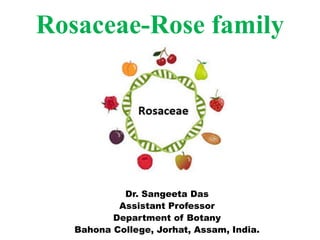
Rosaceae family-Plant Taxonomy
- 1. Dr. Sangeeta Das Assistant Professor Department of Botany Bahona College, Jorhat, Assam, India. Rosaceae-Rose family
- 3. Systematic Position: Class: Dicotyledones Sub-class: Polypetalae Series: Calyciflorae Order: Rosales Family: Rosaceae General characters: Perennial herbs, shrubs, and trees. Vegetative reproduction takes place in several ways for example by runners, by suckers and leafy buds are formed on the roots of some species Pyrus and Prunus. Leaves are petiolate, alternate, stipulate and simple (e.g. Pyrus and Prunus ) or pinnately (Rubus and Rosa) or palmately compound (Fragaria and Potentilla).
- 4. General characters: Inflorescence: Racemes, Corymbs or thyrsoid panicles. Flower: Pedicellate; bracteate, Regular; complete, actinomorphic, hermaphrodite or sometimes polygamous, pentamerous, hypogynous or perigynous. Sometimes epigynous. Calyx: 5 petals, free or basally connate; the calyx tube is free or adnate to ovary, aestivation is imbricate or valvate. Epicalyx: In some species (e.g. Fragaria) an epicalyx of small green leaves is present outside.
- 5. General characters: Corolla: 5 petals. In cultivated species of Rosa there are numerous petals usually imbricate in bud. Sometimes they are absent (Alchemilla) or very small (Neurada). Androecium: Usually numerous. In some species (Agrimonia) there is a single whorl of stamens alternating with the sepal lobes. Gynoecium: It shows much variation. The number of carpels is one to many, the gynoecium consists of either one compound carpel (syncarpous) or many simple carpels (apocarpous). The carpels are usually situated within the hypanthium.
- 6. General characters: Fruits are of different types e.g., pome (Pyrus), drupe (Prunus), follicles, etaerio of achenes (rosa), etc. Seeds: Endosperm usually absent.
- 7. Floral parts of Rosa indica:
- 8. Floral Formula: Important Genera of the family are Rosa indica (rose), Pyrus malus (apple), Prunus persica (peach) , Fragaria vesca (Strawberry) Eriobotrya japonica (loquat), Prunus persica (Aru), etc. Important Genera:
- 10. Phylogenetic Affinities: Rosaceae, included under order Rosales of series Calyciflorae of subclass Polypetalae by Bentham and Hooker, are perhaps allied to Calycanthaceae in the order Laurales and to Myrtaceae (Hickey and King, 1988). Some believe Rosaceae to be allied to Saxifragaceae. Hutchinson believed that Rosaceae is derived from the same stock as Dilleniaceae. Rosaceae is also related to Leguminosae, having monocarpellary pistil and in Chrysobalanoideae the flowers being zygomorphic. Fockey in Pflanzenfamilien divided Rosaceae into 6 subfamilies (Spiraeoideae, Pomoideae, Rosoideae, Neuradoideae, Prunoideae and Chrysobalanoideae) whereas Hutchinson divided Rosaceae into 20 tribes. However, majority of the recent workers (Jones and Luchsinger, 1987; Hickey and King, 1988, etc.) divide Rosaceae into 4 well-marked subfamilies---Spiraeoideae, Maloideae, Rosoideae and Prunoideae.
- 11. Economic importance: Fruits: 1. Prunus persica (Peach). • The fruits are edible and rich in vitamins;. • The oil is obtained from the seeds which is used for cooking and other purposes. 2. Prunus domestica (Plum)-The fruits are edible. 3. Prunus amygdalus (Almond). • This is a tree yielding edible seeds. • The oil obtained from the seeds of both the varieties is used in perfumery and medicinal purposes. 4. Prunus armenica (Apricot)- • The fruits are edible and rich in vitamins.
- 12. Economic importance: Fruits: 5. Prunus cerasoides (cherry)- • The fruit is edible and the wood is used for walking sticks. 6. Eriobotrya japonica (Lokat)-Fruits are edible. 7. Fragaria chiloensis (Garden strawberry)- • Used as edible fruits. 8. Pyrus communis (Pear)-The fruits are edible. 9. Pyrus malus (Apple)- The fruits are edible, delicious, rich in iron and vitamins. 10. Pyrus pyrifolia (Chinese pear) • Used as edible fruits
- 13. Economic importance: Ornamental Plants: A large number of plants of this family are ornamental. They are grown in gardens for their beautiful and scented flowers. • The genus Rosa is widely cultivated for decorative purpose. Rosa damascena. Rosa centifolia, Rosa chinensis and Rosa alba have been in cultivation since ancient times. • Many other genera such as Spiraea corymbosa and Spiraea cantoniensis are also grown in gardens and parks for beautiful flowers.
- 14. Economic importance: Wood: • The branches of Crataegus are used as walking sticks and wood. • The wood of Pints pactia is used for making tobacco pipes.
- 15. Economic importance: Commercial uses: The petals of some common roses are called gulabs in many Asian countries like Pakistan. These petals are used for making gulkand. Petals of rose are used tor extraction of rose oil. This oil is used in perfumes. Medicinal uses: • The petals give Ark-Gulab on distillation with water. This Ark-Gulab is used for curing eye disease and for many other purposes. • Potentilla nepalensis-this is medicinal plant used as a remedy for burns. • Potentilla reptans-The infusion of the herb is used as a remedy of diarrhoea.
